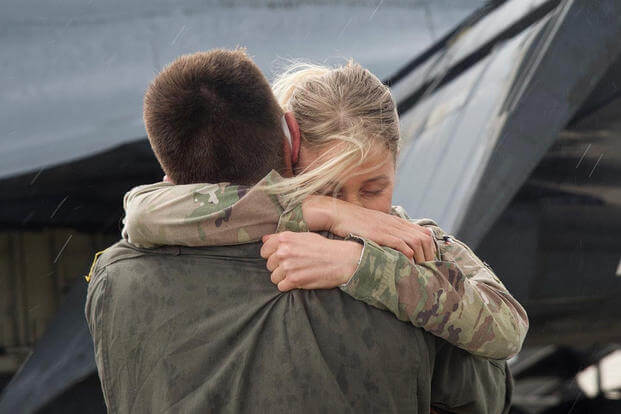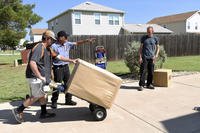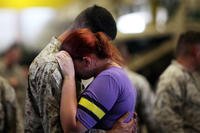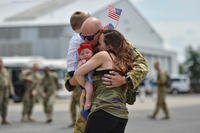I like to watch football trapped in a crack. This is more comfortable than it sounds. I like to wrap up in a quilt, prop my head on Brad’s lap and scoot back as far as I can in the crack between couch cushions while the announcers drone on and on and I tumble into blissful sleep.
Until those guys start talking about military families. I woke to one of them saying, “Unfortunately our troops come back to their own battle -- the battle to return to their lives at home.”
All a sudden, I had an image of Brad crouched in the weeds outside our house, helicopters circling our roof, barbed wire wrapped around the porch swing and “Go away Brad!” signs hung at every window.
My eyes popped wide open -- because I think Americans have backed ourselves into a crack here, a comfortable crack, but a crack just the same. On one hand, we have learned the lessons of Vietnam. We know we have a responsibility to the troops who serve. We know that veterans who return with symptoms of PTSD need to be able to access good psychological care. No barriers. No shame. No surprise that PTSD symptoms are often the very normal result of their battle experiences. Got it.
On the other hand, in our eagerness to do the right thing by battle-scarred troops, we have convinced ourselves that every military member who deploys anywhere returns home to battle very serious problems. That simply isn’t true. Although most military couples have a bit of an adjustment period following deployment, it isn’t much of a “battle.” Last month I had one Army wife describe their post-deployment adjustment period as taking “a couple of minutes.”
That is because there is a huge difference between deployment and combat. I don’t think the people on TV really know that anymore. While nearly everyone in combat deploys, not everyone who deploys experienced combat. Not everyone who experiences combat experiences the kind of combat that can spark the symptoms of PTSD -- like being injured or having a friend who was seriously wounded or killed or seeing enemy combatants wounded or killed.
It is tempting to climb back into the crack and make the assumption that only soldiers or Marines experience combat so they are the only ones who battle. But that is too easy. Combat experiences also happen to sailors who are assigned as individual augmentees. Medical personnel who treat the results of war daily. Commanders who send flight crews out on a mission and then never see them come home. We can’t look at a uniform and know what someone has or has not been through. And they aren’t prone to spouting such personal information.
So what do we do with this information? How are we supposed to understand the differences between combat and deployment without blundering around asking service members if they shot anyone? (Which would be really, really dumb.) I think what I am asking is for all of us to stand up and get out of that comfortable crack of believing just one thing about life in the military. Assuming that every service member is in some way damaged by his or her service is wrong. It is equally wrong to think that we can send military members to war and have them come home completely unchanged. Living with those two truths is uncomfortable. But it is discomfort we can surely stand.
Keep Up with the Ins and Outs of Military Life
For the latest military news and tips on military family benefits and more, subscribe to Military.com and have the information you need delivered directly to your inbox.






















